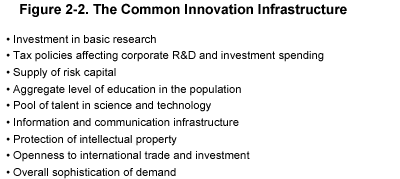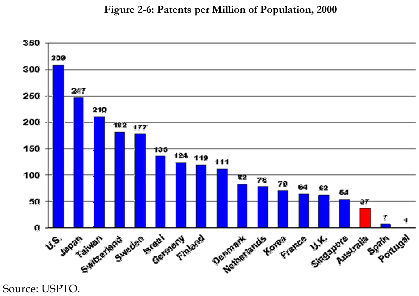|
|
|
Opinion- 26 August 2003 |
|
|

It's a tale of three documents. The first an assessment from the world of academe, the second an evaluation commissioned by the Department of Education, Science and Training and the third an "issues paper" released by the Department. They make interesting comparative reading and it would have been to the Department's and the Minister's credit had the latter two referred to the first. They don't.
The three documents are available online.
Assessing Australia's Innovative Capacity in the 21st Century, Melbourne Business School, Working Paper 2003-16, by Joshua Gans and Scott Stern. (June 27, 2003 )1
Evaluation of the Cooperative Research Centres Programme, Howard Partners Pty Ltd, commissioned by the Commonwealth Department of Education, Science and Training. (July 2003)2
Evaluation of Knowledge and Innovation Reforms Issues Paper. Department of Education, Science and Training. (August 2003)3
The Academic co-authors assessing Australia's innovative capacity are Joshua Gans, Melbourne Business School, and Scott Stern, Northwestern University, Evanston, Illinois. Michael Porter, who has worked with both of the authors, wrote the forward; he cogently sums up Gans' and Stern's findings:
...The analysis confirms the key findings of prior work, including the importance of world-class research-oriented universities and the crucial role played by regional clusters.
These findings, and the policy recommendations that flow from them, should be at center stage as Australia faces the next competitiveness challenge...
Achieving a higher level of innovative capacity requires attention to all aspects of the innovation system...
Though individual companies are the ultimate engine for innovation, the national innovation environment has a strong influence on whether companies are able to develop and commercialize new products and processes at the global technology frontier. With a highly educated workforce, mature political institutions, and a rich history of growth and adaptability, Australia has great promise to establish itself as a source of global innovation. Achieving this objective will require systematic attention to the drivers of innovative capacity in the Australian context;...
Surprisingly, the importance of clusters, i.e. a geographical grouping of complementary knowledge organisations, is not mentioned at all in DEST's issues paper even though their commissioned report from Howard Partners, Pty Ltd wrote in July when evaluating the CRC's:
[T]he start-up route to research adoption is an important aspect of contemporary industrial innovation, particularly in technology intensive industries. Start-up companies, as “New Technology Based Firms” (NTBFs) are important in the technology acquisition strategies of larger corporations – either as direct acquisition or through strategic alliance arrangement – particularly in the setting of a “knowledge cluster”. (p.81)
Similarly the issues paper refers neither to intellectual property nor to patents although Howard Partners repeatedly refers to both in its CRC evaluation. Gans and Stern sum up their evaluation of the factors determining innovative capacity in their figure 2.2.

And they then produce what ought to be an alarming graphic for the year 2000 of the number of patents granted per million population.

With regard to the CRCs Howard Partner's evaluation makes an interesting comment in respect of publicly funded research more for how its comment is phrased rather than what is said:
Australia’s R&D effort compared to other OECD countries is disproportionately focussed on public research, which lacks strong commercial benefits and results in weaker spillover effects to the broader economy. The Group notes that all other countries (with the exception of New Zealand) put the balance of their R&D into private (businesses) rather than public R&D.
And it goes on to produce the following table showing where CRC resources are derived -- industry contributing one-sixth. Which gets us back to a point Gans and Stern make regarding, "Tax policies affecting corporate R & D investment spending."

Over the past four years or so Porter, Gans and Stern have developed what they term the Innovation Index (see below) and Gans and Stern conclude their analysis by listing the Innovation Indices for 29 countries from 1980 - 2000. Here is a condensed table listing the values for 1980 and 2000. But significantly between 1996, the year the Coalition assumed Government, and 2000 Australia's Innovation Index dropped (52.8-50.9). In contrast Canada's rose (73.7-81.4), as did the UK's (54.4-79.4), Finland's (98.6-173.1) and Iceland's (57.6-130.7) to cite four examples.
Overall during the 1996 -2000 period the Innovation Index rose in 23 of the countries surveyed, was unchanged in 1 and fell in 6.
|
Nation |
(rank) Innovation Index |
|
|
1980 |
2000 |
|
| United States | (1) 145.4 | (1) 214.4 |
| Sweden | (3) 85.4 | (2) 184.7 |
| Finland | (13) 28.2 | (3) 173.3 |
| Japan | (5) 68.6 | (4) 171.6 |
| Switzerland | (2) 116.8 | (5) 149.7 |
| Iceland | (19) 10.5 | (6) 130.7 |
| Denmark | (14) 24.4 | (7) 116.3 |
| Germany | (4) 74.8 | (8) 109.5 |
| Canada | (9) 49.5 | (9) 81.4 |
| United Kingdom | (7) 54.6 | (10) 79.4 |
| France | (8) 50.4 | (11) 77.6 |
| Belgium | (12) 28.5 | (12) 75.1 |
| Norway | (10) 31.8 | (12) 75.1 |
| Netherlands | (6) 55.8 | (14) 68.7 |
| Ireland | (21) 4.9 | (15) 62.3 |
| Austria | (14) 24.4 | (16) 52.4 |
| Australia | (16) 20.6 | (17) 50.9 |
| South Korea | (26) 0.6 | (18) 42.3 |
| Italy | (18) 12.5 | (19) 19.7 |
| Spain | (23) 3.2 | (20) 17.3 |
| New Zealand | (20) 9.1 | (21) 14.9 |
| Czech Republic | [1993 value] (17) 14.0 | (22) 14.5 |
| Greece | (27) 0.5 | (23) 12.0 |
| Portugal | (25) 0.8 | (24) 11.1 |
| Hungary | (10) 31.8 | (25) 5.4 |
| Poland | [1993 value] (24) 2.1 | (26) 3.5 |
| Slovak Republic | [1995 value] (22) 4.4 | (26) 3.5 |
| Turkey | (28) 0.4 | (28) 1.4 |
| Mexico | [1993 value] (29) 0.4 | (29) 1.2 |
According to Porter, "research [to produce and Innovation Index] began in 1999 with the National Innovation Index Project at the Council on Competitiveness. This study aimed to diagnose the long-term challenges for sustaining innovation and competitiveness in the United States. Scott Stern and I identified the centrality of regional clusters and a strong national innovation infrastructure as key drivers [it is now] an ongoing line of research and is an annual component of the World Economic Forum’s Global Competitiveness Report." While Gans and Stern write, "The Index, interpreted literally, is the expected number of international patent applications per million persons given a country’s current configuration of national policies and resource commitments." (p23, see their Figure 2.7)
The Howard Partner's report on the CRCs observes, "The potential for substantial national economic benefits is generally reported by CRCs as being high, but demonstrated actual benefits are a little more difficult to come by. That said, the focus of the CRC Programme is on long-term research, and truly groundbreaking research may take many years to result in application.
"The issue here is the capacity to realise potential economic, social and environment benefits through application and adoption by end users. At this stage, it may be too early to translate the potential benefits into application and adoption."
Perhaps the affect on the nation's Innovation Index?
They then provide the following table, a salutary lesson concerning "gaps in communication".

Returning to Gans and Stern they give a prominent role to universities as regards innovation but not in the rather narrow sense (lip service not withstanding) that has been exhibited in current government circles:
First, universities must continue to upgrade their role as key linkages in the Australian innovation system. In leading innovator economies, the university system provides required training for a technically skilled labour force. It also undertakes “basic” research investments that serve as the foundation for a country’s industrial clusters. Finally, by serving as a neutral broker within and among companies themselves, universities serve to serve as a knowledge hub through which spillovers are achieved.
And sum up their assessment:
At present, the bulk of the world’s innovations are developed and commercialised by a relatively small number of top tier innovator economies. These nations have put themselves in that position through commitments to enhance and sustain innovative capacity within their country.
The role of the government is to ensure that the basis exists in Australia’s innovative capacity by investing heavily on the three dimensions identified in this report [and see their table 2-2 above] – a common innovation infrastructure, the cluster-specific environment and the quality of linkages... Australian strength in a few key areas can serve as the basis for international competitiveness and the source of Australian new-to-the-world innovation.
To an outside observer it might appear surprising that the expertise of individuals such as Gans, Stern or Porter haven't been utilised, if as Minister for Education, Science and Training, Dr. Nelson has an abiding interest in evaluating the reforms that have been either furthered or put into place by the Coalition government to extend the nation's knowledge and innovation base.
If evaluating the CRCs merits a critical assessment at "arms length", surely so do those of the "knowledge and innovation reforms." But by the look of things, it ain't gonna happen.
Alex Reisner
The Funneled Web
1.
http://www.mbs.edu/home/jgans/papers/Innovation
Index Australia.pdf![]()
2.
http://www.crc.gov.au/Docs/pdf/Report Final 1.0.pdf![]()
3.
http://www.dest.gov.au/highered/ki_reforms/issues_paper.pd![]()